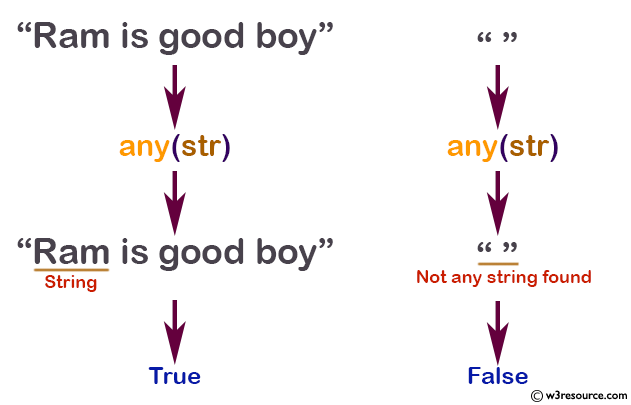Python: any() function
any() function
The any() function returns True if any element of the iterable is true. The function returns False if the iterable is empty.
Syntax:
any(iterable)
Version:
(Python 3)
Parameter:
| Name | Description | Required / Optional |
|---|---|---|
| iterable | A container is considered to be iterble, which can return its members sequentially. | Required |
Return value:
Return True if any element of the iterable is true.
Example:
def any(iterable):
for element in iterable:
if element:
return True
return False
Python: any() example with Strings:
str = "Ram is good boy"
print(any(str))
# 0 is False
# '0' is True
str = '000'
print(any(str))
str = ''
print(any(str))
Output:
True True False
Pictorial Presentation:

Python: any() example with Lists:
num = [23, 45, 0, 30]
print(any(num)) #True
num = [0, False]
print(any(num)) #False
num = [0, False, 5]
print(any(num)) #True
num = []
print(any(num)) #False
Output:
True False True False
Python: any() example with Dictionaris:
dict = {0: 'False'}
print(any(dict))
dict = {0: 'False', 1: 'True'}
print(any(dict))
dict = {0: 'False', False: 0}
print(any(dict))
dict = {}
print(any(dict))
# 0 is False
# '0' is True
dict = {'0': 'False'}
print(any(dict))
Output:
False True False False True
Python: any() example with Tuple
#Test if all items in a tuple are True:
tup = (0, True, False)
x = any(tup)
print(x) #True
tup = (2, 3, 4)
x = any(tup)
print(x) #True
Output:
True True
Python: any() example with Set
#Test if all items in a set are True:
sss = {0, True, False}
x = any(sss)
print(x) #True
sss = (1, True, True)
x = any(sss)
print(x) #True
Output:
True True
Python Code Editor:
Test your Python skills with w3resource's quiz
Python: Tips of the Day
Find current directory and file's directory:
To get the full path to the directory a Python file is contained in, write this in that file:
import os dir_path = os.path.dirname(os.path.realpath(__file__))
(Note that the incantation above won't work if you've already used os.chdir() to change your current working directory, since the value of the __file__ constant is relative to the current working directory and is not changed by an os.chdir() call.)
To get the current working directory use
import os cwd = os.getcwd()
Documentation references for the modules, constants and functions used above:
- The os and os.path modules.
- The __file__ constant
- os.path.realpath(path) (returns "the canonical path of the specified filename, eliminating any symbolic links encountered in the path")
- os.path.dirname(path) (returns "the directory name of pathname path")
- os.getcwd() (returns "a string representing the current working directory")
- os.chdir(path) ("change the current working directory to path")
Ref: https://bit.ly/3fy0R6m
- New Content published on w3resource:
- HTML-CSS Practical: Exercises, Practice, Solution
- Java Regular Expression: Exercises, Practice, Solution
- Scala Programming Exercises, Practice, Solution
- Python Itertools exercises
- Python Numpy exercises
- Python GeoPy Package exercises
- Python Pandas exercises
- Python nltk exercises
- Python BeautifulSoup exercises
- Form Template
- Composer - PHP Package Manager
- PHPUnit - PHP Testing
- Laravel - PHP Framework
- Angular - JavaScript Framework
- Vue - JavaScript Framework
- Jest - JavaScript Testing Framework
